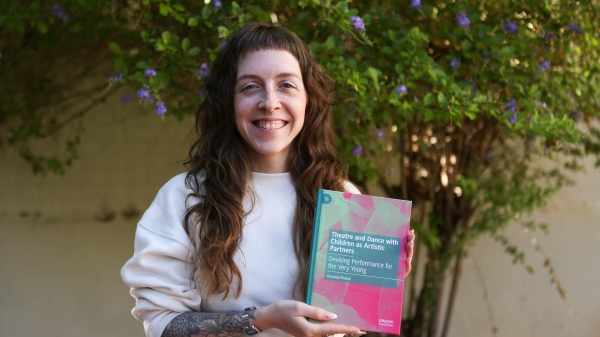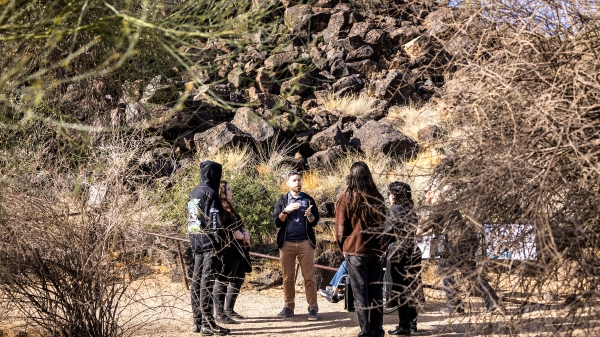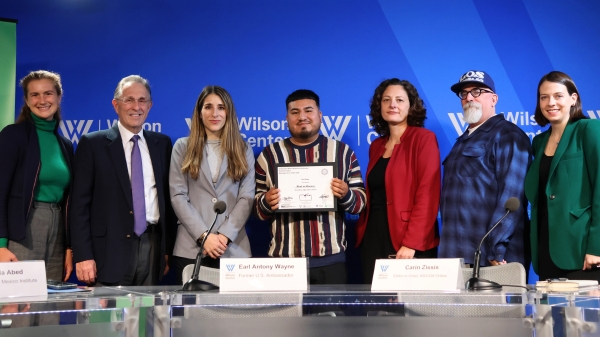'Drumfolk' to bring the African American tradition of stepping to ASU Gammage

Renowned dance company Step Afrika! will bring the African American tradition of stepping to audiences in their upcoming performance of "Drumfolk" at ASU Gammage on Saturday, Oct. 29. Photo courtesy ASU Gammage
When Africans lost the right to use their drums, the beats found their way into the body of the people — the "Drumfolk." New percussive art forms took root and made way for tap, beatboxing and the African American tradition of stepping, which the renowned dance company Step Afrika! hopes to bring to audiences in their upcoming performance of "Drumfolk" at ASU Gammage on Saturday, Oct. 29.
Step Afrika! combines dance, song, storytelling and humor to create a heart-pounding experience that celebrates the African American tradition of stepping.
Founded in 1994 by C. Brian Williams, Step Afrika! is the first professional company dedicated to the tradition of stepping. Under Williams’ leadership, stepping has evolved into one of America’s cultural exports, touring more than 50 countries across the globe. Step Afrika! now ranks as one of the top 10 African American dance companies in the United States.
Here, Williams shares more about the company's background and what he wishes for audiences to gain from the show:
Question: Can you tell us about the founding of the Step Afrika! dance company?
Answer: Step Afrika! is entering its 29th performance season. In 1994, Step Afrika! began as a festival designed to (fuse) the African American art form of stepping with South African dances and traditions. From that two-week festival, a program of artistic and cultural exchange has grown and is now one of the largest African American dance companies in the world today. We have 14 full-time cast members who are not only excellent performers, but outstanding artists (who) perform and teach all over the world.
Q: What inspired you to tell the story of "Drumfolk" through the tradition of stepping?
A: "Drumfolk" is inspired by two very rarely talked about moments in American history. The first one is the Stono Rebellion of 1739, which led to the Negro Act of 1740. Both of those moments in American history greatly impacted the development of not only American cultural history, but more specifically African American culture and experience. We say that "Drumfolk" was the result of over 29 years of percussive practice and research into the American origins of stepping. We look forward to sharing that with audiences, both on stage and in discussion.
Q: What can audiences expect at the show?
A: Audiences can expect a lot of energy. Step Afrika! practices the art of step. Stepping is a polyrhythmic percussive, highly energetic dance form created by African American fraternities and sororities. You are going to get to see us stepping in distinct and unusual ways in this production. But you’re also going to experience traditional dance forms. We have several guest artists that join us for this production: a beatboxer, who brings a really exciting element to the show; live drumming — we have some amazing traditional African drummers who will join us for the show; and then a special vocalist.
Q: What do you hope the audience leaves with after seeing "Drumfolk"?
A: First things first, the audience needs to enjoy their time with the show. I love going to the theater, no matter what's on stage. And I love for audiences to come in and witness art forms, traditions and cultures that maybe they haven’t had too much experience with. So first, I want them to enjoy this tradition of stepping, which is a part of our nation’s cultural heritage.
I also am excited about sharing this bit of history. It has been in American history, but we found that over 90% of our audiences have never heard of the Stono Rebellion or the Negro Act of 1740. We really encourage audiences to Google both of these American historical moments prior to our arrival on stage and then afterwards. I love for them to do a little research even before, because I think the show will be that much richer if they do.
Q: What do you look forward to most about performing in Tempe?
A: I just love the theater. It is a massive space. It’s an incredibly beautiful space. We’ve only performed there once before with a smaller production. I’m excited to return with one of our features that is unlike traditional dance. We have a set, lots of costume changes and a pretty large cast. I just can’t wait to get on that stage. I’ve wanted to return to this community for some time, and I’m just really excited to be back in Arizona. ASU Gammage is really fantastic and a unique venue. I love the opportunity to perform there.
Q: Do you have any advice for aspiring dance and movement-based artists?
A: The first advice I would give any dancer or movement-based artist is to explore as many styles as possible. You may have a distinctive style, but becoming well-rounded in the form and practicing and having access to multiple dance styles, not just one, can create a far more interesting dancing career. I’m a huge fan of the well-rounded artists who have experience with multiple dance styles and multiple traditions. Dance requires its artists to be able to master several different styles. I am a big fan of versatility in dancers.
Tickets for "Drumfolk" at ASU Gammage on Oct. 29 are on sale now at asugammage.com.
More Arts, humanities and education

ASU professor explores theater, dance for young children in new book
Arizona State University Assistant Professor Amanda Pintore believes in the artistic capacity of very young children. She's…

Petroglyph preserve celebrates 30th anniversary with ancient, modern tales
The Deer Valley Petroglyph Preserve provides a beautiful walk through a pristine desert where chuckwalla lizards are as plentiful…

Kaleidoscope short film contest inspires powerful binational filmmaking in its second year
“We come to this country not to steal anybody’s jobs but to take advantage of the opportunities that the rest ignore. We’ve been…